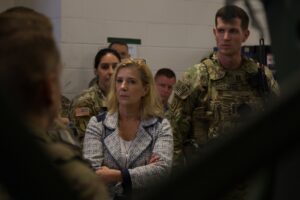After recently installing a new leader and on the heels of the Army’s rollout of its doctrine for future multi-domain operations, Secretary Christine Wormuth said Monday she sees ‘plenty of work ahead’ for Futures Command beyond the its work helping develop the current portfolio of modernization systems.
Wormuth’s remarks arrive as the Army is set to publish its new ‘Field Manual 3-0, Operations’ doctrine on Tuesday, which sets the path for how the service plans to modernize its capabilities and concepts by 2030 to best posture for future fights.

“I don’t see Army Futures Command (AFC) going anywhere, anytime soon. 2030 is still eight years away, so there’s a lot of work that has to be done to be able to deliver the systems that we’re already working on in the six major modernization portfolios. And AFC and [the Army’s acquisition office] are going to work together to get that done,” Wormuth said during a press briefing at the Association of the United States Army’s annual conference in Washington, D.C.
The Army’s modernization agenda is focused around developing “31+4” signature systems across those six priorities: integrated air and missile defense, long-range precision fires, future vertical, next-generation combat vehicles, soldier lethality and the tactical network.
Officials have noted that 24 of the Army’s signature modernization systems are planned to start being delivered in 2023, noting that’s likely in small quantities for many instances as programs continue through testing and potentially ramp up toward production.
Last week, Gen. James Rainey officially took over as Futures Command’s new and second-ever leader, 10 months after Ret. Gen. Mike Murray retired following his time as the command’s inaugural commander.
Rainey, who was most recently the service’s deputy chief of staff for operations and training, now takes helm of the Austin, Texas-based Futures Command as the Army begins to assess how the organization will help shape the service beyond its current modernization portfolio.
Wormuth in May signed a new directive that more narrowly defined Futures Command’s roles, which she has said was aimed at addressing any ambiguities in the responsibilities between AFC and the Army’s acquisition office (Defense Daily, May 5).
The memo eliminated previous language from earlier guidance that established Futures Command as “leading the modernization enterprise” and reiterated that the assistant secretary of the Army for acquisition, logistics and technology (ASA(ALT)) office owns both acquisition and oversight of research and development (R&D) efforts.
During a House Appropriations Defense Subcommittee hearing in May, Wormuth reiterated there are no plans to downgrade Futures Command in the wake of a recent memo and that it will remain a four-star command (Defense Daily, May 17).
“I think there’s plenty of work for Army Futures Command for years to come,” Wormuth said on Monday.
Wormuth reiterated that Futures Command will have a “really important role” in helping to define the next operating concepts and technologies that will be required beyond the current doctrine out 2030, looking at 2040 and beyond.